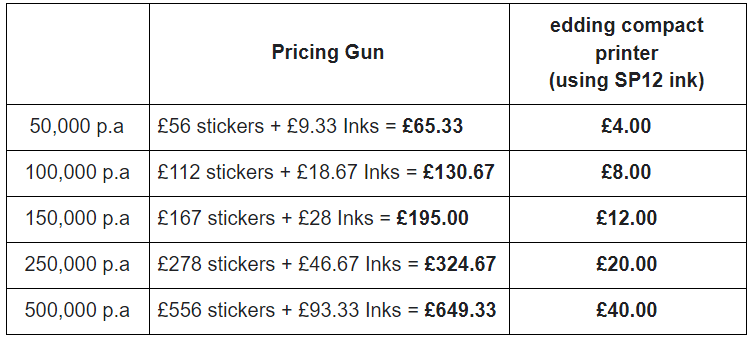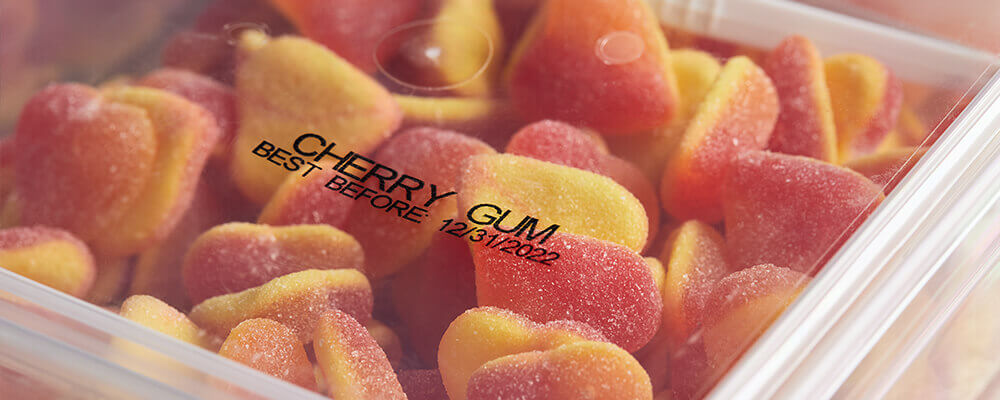edding compact printers are a new generation of thermal inkjet (TIJ) marking and coding solutions for industrial use. Unlike sticky labels, inkjet codes are highly unlikely to be removed accidentally. Also, the high resolution codes look more professional when applied to high quality products. Most importantly, an edding compact printer will run at a fraction of the cost by eliminating paper labels and sticker gun ink cartridges.
Operating cost comparison
To illustrate the cost savings of an edding compact printer, we’ll compare labelling costs with those from using a pricing gun. To keep the comparison fair, we’ll set the label format to 2 lines, 15 characters of 2mm height for BATCH # + BB DATE.

Both the edding compact printer and the pricing gun will need consumables. For the pricing gun, these include dual line inks and 2-line stickers. For the edding compact printer, the only consumable are its ink cartridges.
The costs of the pricing gun’s consumables are:
- 5 x dual line inks by Sato that you can get for £14.00. Each ink can last for around 12,500 impressions.
- 36,000 x 2-line stickers that you can get for £40.00 which is equivalent to 900 labels for £1.
For the edding compact printer, the SP12 ink cartridge costs £78 and will yield around 975,000 prints.
Now that we have the consumables costs, let’s look at a few scenario comparisons:

With the edding compact printer, a business will save £61.33 per 50,000 items printed. As the number of items printed increases, the total amount of savings will increase as well. For many businesses, these cost savings can be substantial.
Capital expenditures
In the above, we have only considered Opex. So let’s briefly take Capex into account: An edding in-line printer costs £3,300 in our shop. A pricing gun usually costs £50
At which point does it make sense to switch?
Considering the above capital expenditures, our calculations show that at around 300,000 prints per year and more (i.e. around 1,150 prints per production day), and considering an average lifetime of 5 years for an edding compact printer and 2 years for a pricing gun, it’s more economical to use a TIJ solution such as the edding compact printers.
Put differently, if you print on more than 1,150 units per production day, get yourself an edding compact printer.
If it’s less than that, it’s cheaper to use a pricing gun. However, this does not take into account several other benefits of having a more professional printing solution, as explained in the following paragraph.
Other points to consider
Using a semi-automated solution like an edding compact printer has many indirect benefits:
Direct marking is less labour-intensive. A person sticking individual labels on products can now be deployed elsewhere within the production process. This improves productivity and efficiency.
More permanent code / mark on a product. No labels peeling or falling off.

Less waste going to landfill in terms of label backing paper and empty ink rolls. Improved sustainability and environmental impact.
High quality, professional look of digital codes versus paper stickers on a product.
edding compact printers can connect to any production PC or laptop, and even smart devices (e.g. tablet and smart phone) – allowing control of the printer remotely from an office, as well as storing all codes / messages in the printer itself or on a PC.
Easy storage of 1 or 2 ink cartridges per annum, instead of multiple rolls of stickers and ink rolls which can get easily lost in storerooms.
Conclusion
Through our analysis, we can see that the edding compact printer is more cost-effective when comparing the price of consumables in many manufacturing use cases.
Get in touch with us to learn more about edding compact printers.